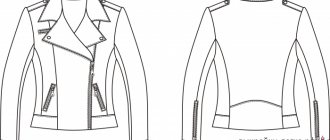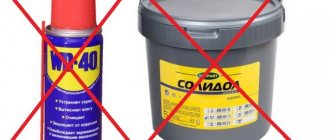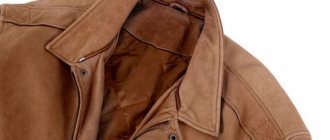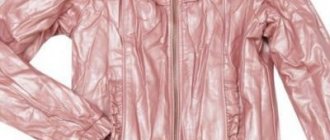Their leatherette outerwear is usually not environmentally friendly and durable. And in our stores you can’t always be sure that a beautiful product is a natural product and not an artificial one. Reasonable people prefer to buy genuine leather in order to order a jacket, raincoat or coat from it and, as a result, be satisfied with outerwear made of high-quality breathable material.
Restoring a jacket is a painstaking, almost jewelry-like process. On the Internet you can find both photos and videos that tell in detail how to repair a leather jacket yourself. But the recommendations are not always feasible - either special equipment or skills in working with specific materials are required. If you decide to take on leather repairs yourself, check out the important tips below. They will help you successfully solve this problem.
How to fix a gap with your own hands
It is believed that leather is a fairly durable material, but it can also tear. Although, of course, holes appear less often on such products than on fabric and canvas ones. If this has already happened, then the instructions for bringing the jacket into proper shape depend mainly on the form of damage that has occurred. There are situations when the material is torn by a “corner”, and there are situations when a piece of skin flies off completely.
In the first case, the sequence of actions is as follows:
- Provide access to the tear from the inside of the leather jacket. It is necessary to rip the jacket lining along one of the seams.
- Carefully, as far as possible, smooth out the torn corner. Now you need to fit it back and secure it with tape on the front side.
- We glue a patch made of leather, thick fabric or suede from the inside. We make sure that the overlay is larger than the tear site and protrudes beyond each of its edges by 10-15 mm.
- Having smoothed the surface from the inside, we install something heavy on the front side. Leave the load until the patch is completely dry.
- We remove the tape. Apply a thin layer of glue along the entire joint of the gap from the outside (it is convenient to use the tip of a toothpick for this).
- We mask the damaged area with a special leather paint to match the product or a regular cream.
- Sew up the inner lining.
Important: Please note that the tape you take is initially very sticky. It may leave marks on the surface of the jacket. It's better to "weaken" it. To do this, glue it to the surface of your leg, peel it off, and then use it for its intended purpose.
In a situation where the hole in the jacket is obvious and a piece of material is completely torn out, repairing the product is somewhat different.
- We rip the lining from the inside in order to get to the place where the skin is torn.
- We level the damaged area as much as possible, glue a patch from the inside, and place a weight on it.
- After the glue has completely dried, we repair the front part of the product. If the “original” torn piece is lost, you need to cut another one from a flap of leather, which is as similar in characteristics as possible to the material of the jacket. We make sure that it is identical to the shape of the hole. We put this piece into the hole.
- Carefully fill the resulting joint with glue along the entire perimeter of the outer patch.
- After everything has dried, paint over the damaged area. Sew up the ripped lining.
If the gap is large and is in plain sight, then repairing it with your own hands will be quite problematic. It is better to contact qualified craftsmen for help in the studio. If an area of skin needs to be replaced, specialists will be able to select the most suitable flap and carefully stitch it in the right place.
Tip: Alternatively, you can seal the jacket yourself and add leather patches. Particular attention should be paid to masking the damage. For example, you can install additional decor in this place. This approach will not only hide traces of the tear, but will also give the jacket originality.
How to sew up holes and cuts
In order to stitch the product, you will need a sewing machine, a special strong needle, a prepared leather patch and threads of a matching color. This largely determines how carefully you can deal with eliminating defects on a jacket at home.
Restoration of leather canvas consists of several steps:
- We get to the place of the tear from the inside of the jacket (to do this we rip the lining).
- We trim the edges of the hole, making them as even and smooth as possible. We prepare a fabric patch, which we apply in this place. We take into account that the flap should protrude beyond the edges of the “wound” by 1.5-2 cm.
- A piece of skin, which is slightly larger in size than the damaged area, is applied externally. Make sure that both patches are positioned evenly in relation to the hole.
- Using a sewing machine, attach the patches.
Important: make sure that the needle is strong enough and suitable for working with leather. Otherwise, you can not only ruin the jacket, but also damage the sewing machine.
Restoring elasticity
To refresh an old jacket, as well as to avoid the formation of cracks, abrasions and drying out of the material, it is necessary to treat it with products containing fats, for example, such as:
- Castor oil. Mix the protein with 50 ml of castor oil until smooth and process the product.
- Butter. For 3 liters of water you need 3 parts of the product. Add ammonia 3:1.
- Laundry soap. Dissolve half a piece of the product in 1 liter of hot water. Add ammonia - 1.5 tbsp. l. and fish oil - 1 tsp.
- Acetone. Wipe the item with it, then with glycerin.
Patent leather, suede and nubuck items should not be treated with these products.
How to fix a collar
If this section of the fabric is torn, then the damage can be repaired using any of the previously described methods.
Owners of leather jackets note that one of the most common problems they encounter is the appearance of greasy marks on the collar. This happens if the product is worn for a long time and is not cleaned in a timely manner. There is a way to deal with this problem:
- We treat areas of the skin that have lost their attractive appearance with gasoline. Let the material dry and check the result. If necessary, repeat this manipulation several times.
- After removing all traces of fat, a special paint will allow you to restore the original color of the skin. Using a sponge, carefully paint the collar. Make sure that the product spreads evenly over the entire treated area.
Remember that at home there is always a risk of damaging the product due to careless actions. To prevent this, test the described method in an inconspicuous place. And only then boldly get to work restoring the proper appearance of the collar.
The question remains: if the leather on the jacket is cracked in this area, what should I do? To eliminate such defects, it is advisable to use special dyes that match the color. However, it is better not to use those that come in the form of sprays. Such products are usually sprayed from a distance of 30-40 cm, due to which the dye goes beyond the collar and falls on a larger area.
Repair using liquid leather
Today, the market offers a wide range of products that greatly facilitate the repair process. Particular attention should be paid to such a product as liquid skin. It allows you to quickly and easily eliminate various types of damage to the main fabric, pockets, collar and cuffs.
Important: before working with this product, the damaged area must be cleaned of dirt, degreased and thoroughly dried. Otherwise, the actions taken to restore the product may be ineffective.
By choosing liquid leather to match the jacket, you can cope with both deep scratches and through cuts. The only difference in repair is that in the second case, you will need to glue a piece of fabric or leather from the inside that completely covers the cut. The rest is simple:
- Apply the product in 1-2 layers (depending on the depth of the damage) to the edges of the scratch. Make sure that liquid skin does not fall outside the cut. If this happens, remove the excess with a dry sponge.
- Before the mixture begins to dry out, blot the damaged area with a clean cloth. This will somewhat eliminate differences in the surface textures of the jacket and the applied product.
Carefully follow the instructions for use of liquid leather and repair outerwear at home without resorting to the services of professionals.
Cleaning the product
To remove dirt, dust and abrasions from a jacket, the following remedies are effective:
- Soap solution. Gets rid of non-greasy stains. Heat some water to a temperature of 45-50 degrees Celsius, add detergent. Wash off stains with a soft sponge, wipe with a damp, clean cloth and dry any remaining moisture with a cloth.
- Gasoline or turpentine in purified form. Apply to a cotton pad to remove stains. When cleaning, there is no need to generously wet the material with solvent to avoid degreasing it.
- Ammonia and liquid soap. Mix the ingredients, moisten a cotton pad with the mixture, and wipe the product with it.
The inside needs to be processed from time to time.
The lining also needs to be cleaned regularly. Procedure to complete:
- Turn the item inside out and pull back the lining fabric.
- Wet the lining well with water and rub with soap.
- Rinse off the soap and remove any remaining residue with a damp, non-soap sponge. When adding 9% vinegar, the procedure is faster.
- Turn the product inside out and dry it vertically.
Return to contents
How to repair a leatherette jacket
Faux leather is a rather difficult material to repair. Therefore, if damage is detected, it is better to transfer the item to specialists for restoration. They will be able to eliminate defects, successfully disguise the repair site, and even replace a section of eco-leather if necessary.
Of course, it is not always possible to take the product to a workshop and you have to think about repairs yourself. Find out which repair products are appropriate to use in each specific situation. So, if a leatherette jacket is cracked, what to do is always a pressing question.
When the scratches are shallow and small, a good solution to the problem would be to use an aerosol bottle with a dye. The main thing is to choose a tone identical to the product. And then, following the instructions on the bottle, it will not be at all difficult to give the jacket a fresh look and disguise the damaged area.
Important: spray it from a safe distance (at least 30 cm) and apply it in a thin layer. This will help prevent the formation of drips on the canvas.
For more noticeable scratches, it is better to use dyes that penetrate deeper into the artificial material. Similar substances with pigments are applied to the jacket with a soft sponge or a special brush and distributed evenly over the surface. After 30-40 minutes, the paint layer dries, and the jacket regains its attractive appearance.
If punctures or deep cuts form on the canvas, you can deal with them yourself by using liquid leather. The instructions for its use in this case are similar to those described above for the restoration of leather products.
How to restore a peeling jacket
As a result of excessively long use or after unsuccessful washing using aggressive powders, a leather jacket may begin to peel. If the damaged areas are small and not in the most visible places, special dyes can be used to disguise them. By being able to choose the most suitable color, you can hide the defects that appear and extend the life of the leather product.
The shabby area can be disguised by gluing decorative elements on top that match the style of the jacket. Such modernization not only restores a pleasant appearance, but also improves it, making it unique.
Tip: It's best to avoid washing your jacket at home. Regular dry cleaning carefully removes various contaminants, maintaining the presentable appearance of the leather product.
Using the above tips and recommendations, you can ensure quality care for your outerwear. If your leather jacket is frayed or cracked, you now know what to do. The main thing is to notice the defect in time, react and apply the right remedy.
Did you like the article? Save it to your Pinterest! Hover over the image and click “Save.”
Adviсe
To avoid having to constantly update your jacket, you need to follow a few rules.
Recommendations:
- Don't put a lot of things in your pockets, they stretch the skin.
- Do not apply hairspray or perfume after putting on your jacket. The alcohol dries and stains the fabric. Apply cosmetics, let them dry and then put on the leather item.
- Do not attach brooches or other adhesive-based items to your skin. This will ruin the appearance.
- Before washing, cleaning stains, look at the label. It indicates the temperature regime, method of drying and washing, and the possibility of using aggressive agents.











